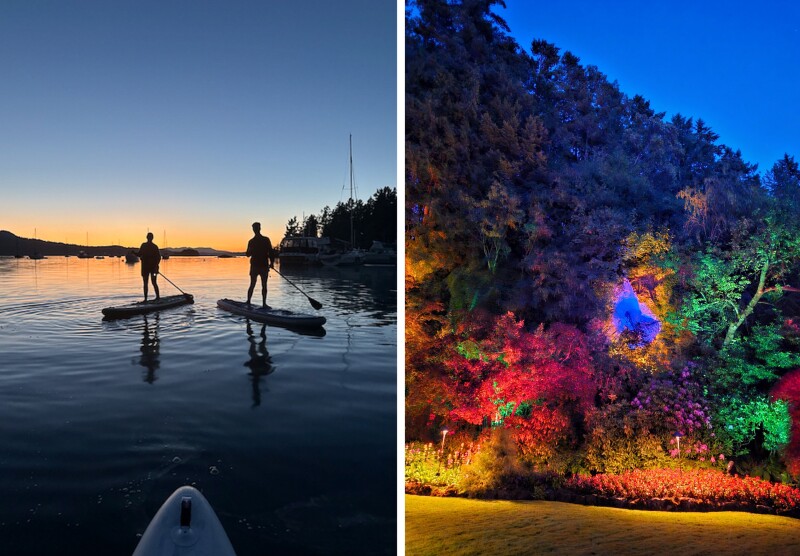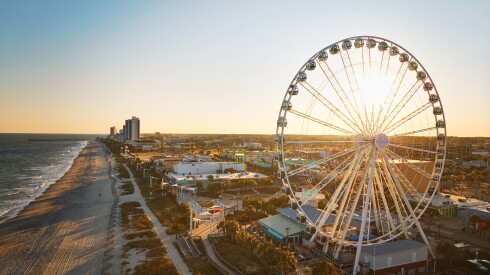This article is part of a series celebrating communities, culture, traditions, and adventures throughout Canada. We’re spotlighting exciting people and places across the country’s provinces, from British Columbia in the west to Newfoundland and Labrador in the east. Read more stories at afar.com/canada.
With so much of our day-to-day lives swamped by artificial light, and true darkness increasingly hard to experience, being outside at night can feel thrilling—almost taboo. Thanks to its wealth of wide-open spaces, Canada is especially rich with outdoor adventures, and the ones you take at night can offer a different, sometimes transcendent look at the world. Snowshoeing on fresh powder through a moonlit forest or staring up at the stars in a pristine prairie sky, I have found my senses elevated to high alert, connected with a more primal environment and my more instinctive self. Here are six “noctourism” trips, spread across the country, on which you, too, can experience a different kind of nightlife.
Paddle an illuminated kayak along a heritage river in New Brunswick
Aspen Bear, a member of the Wolastoqey Nation of the Wabanaki Confederacy and the owner of Wolastoq Adventures in New Brunswick’s capital city of Fredericton, loves taking people out on the St. John River, known as the Wolastoq in the Indigenous Maliseet–Passamaquoddy language. This waterway has sustained her people for thousands of years, and she offers a different perspective on its beauty and bounty by using a fleet of transparent kayaks and stand-up paddleboards equipped with color-changing LED lights, enabling nighttime exploration. On these serene trips, which last one or two hours and cost anywhere from about $25 to about $101 (all prices are in US$), Bear says she often sees prehistoric-looking sturgeon—up to 15 feet long!—leap out of the water. “They’re bottom-feeders, but they’ll breach the water to regulate their swim bladders,” she explains. “We often see salmon jumping, too.” The river runs through Fredericton, and while tours start in the city, within minutes you’ll be paddling under canopies of trees, listening to frogs, insects, and the occasional hoot of a great horned owl.
Where to stay: The Delta Hotel Fredericton is right on the river, with a huge waterfront patio and outdoor pool with oak barrel saunas. The hotel has several highly rated restaurants, but you’re a short stroll from the city’s buzzy craft breweries and its best eatery, 11th Mile, which celebrates fresh and local ingredients in a cozy room.
Snowshoe through Ontario’s winter wonderland
Snowshoeing at night is magical. The sole sounds are the huff of your breath and satisfying crunch as your snowshoes break the ice-crusted powder, with only the light from the moon and the stars above to see by. A mere rustle or a scratch in the branches of the trees makes your nerves turn electric. John Langford, the owner and director of adventure tourism company Voyageur Quest, leads groups on a variety of adventures through Algonquin Provincial Park, and one of his favorite things to do on a multiday adventure is to take guests snowshoeing after dark. “In winter, the nighttime average here is -4 [degrees Fahrenheit] and the colder the night, the clearer the sky,” he says, “so we bundle up and head out in the monochrome terrain of shadows and moonlight.” It’s common to see animal tracks on the pristine snow, and Langford has occasionally spotted wolves in the distance. “And if you happen to be here when the aurora is happening,” he adds, “then wow.”
Where to stay: If you book with Voyageur Quest, your accommodations in Algonquin Provincial Park will be part of the package. You’ll end up spending a lot of time out in the cold, though, so once you make the 158-mile drive back down south to Toronto, warm up at one of our favorite hotels in the city.

Grasslands National Park hosts an annual stargazing festival called the Beyond the Big Dipper weekend.
Courtesy of Stocktrek Images, Inc. / Alamy S/Alamy Stock Photo
See the stars shine in the dark skies above Saskatchewan
The Royal Astronomical Society of Canada has designated more than 30 Dark-Sky Sites in Canada, and according to Parks Canada one of the darkest is Grasslands National Park, a stretch of 281 square miles in the southern Saskatchewan prairie. The stars are so stunning that Grassland National Park interpretation coordinator Nicholas Ypelaar says the sight of them tends to make visitors fall silent. “There’s virtually no light pollution,” he explains. When I stayed at Grasslands last summer, my view of the Milky Way was so bright and clear it seemed impossible: The sky was a carpet of constellations, with shooting stars galore, and I took impressive photos using just the camera on my phone. The skies here are incredible year-round, but a particularly apt time to take them in is during the annual Beyond the Big Dipper weekend, when the RASC provides the park with telescopes. “Then we see nebulas, planets, and celestial bodies that are millions and millions of light years away,” Ypelaar says. “It is just so special.” The dates for Beyond the Big Deeper vary from year to year; in 2025 the event was in late May, in the Grassland National Park’s West Block. Advance booking is recommended ($21).
Where to stay: Make your home base in Val Marie, a small village that’s the gateway to Grasslands, at the Convent Inn, a former convent school that was abandoned until 1996, when the Ducan family transformed it into a bed-and-breakfast. Sleep in the nuns’ old rooms and hang out in the lounge that used to be their classroom. (Check out the inspirational quotes that travelers leave on the chalkboard.)

Banff is known for its skiing and the palatial Fairmont Banff Springs, a historic Canadian Pacific Railway hotel.
Photo by Sid0601/Shutterstock
Hit the floodlit ski slopes in Alberta
Banff is perhaps Canada’s greatest ski town, with three resorts to choose from (Mount Norquay, Banff Sunshine, and Lake Louise), a fun après scene, steamy hot springs, and delicious dining. Mount Norquay is the smallest of Banff’s Big Three, with 60 runs spread across 190 acres, but it’s also the only mountain in the Canadian Rockies to offer night skiing, on Fridays and Saturdays from 5 p.m. to 9 p.m., starting in December. According to Jamie Robinson, who has worked as a ski instructor at all three Banff resorts across the past decade, the local powder hounds love hitting the slopes (and the fully lit terrain park) in the dark. “It’s quieter, the lines for the chair are short, and the floodlit runs offer something for all levels,” he says. “Afterward, we all head over to the Lone Pine for phenomenal food and drinks.”
Where to stay: The most famous hotel here—and one of our favorites in all of Canada—is the Fairmont Banff Springs, a historic Canadian Pacific Railway property that looks like some Habsburg king’s Alpine redoubt. If you couldn’t tell from the name, it’s a great place to take advantage of the Canadian Rockies’ soothing hot springs.

South Island SUP shows paddleboarders British Columbia’s surprising bioluminescent waters (left); Butchart Gardens in Victoria, B.C., lights up its plants and landscape during summer nights (right).
Photos by Brian Raymer/South Island SUP (left); photo by Jakenita Photography/Shutterstock (right)
Go paddleboarding on the bioluminescent waters of British Columbia
We tend to associate bioluminescence—water glowing at night because of chemicals produced by marine microorganisms called dinoflagellates, as well as larger animals like jellyfish—with tropical destinations such as Puerto Rico and Panama. This haunting phenomenon can occur in the north too, and you can witness it just outside Victoria, B.C., on a South Island SUP nighttime paddleboarding tour (two to three hours, starting at $65). “We paddle into this little inlet under the cover of trees to block out the moonlight and lie down on the boards to watch,” says South Island SUP owner Brian Raymer. “It’s just so beautiful, and often we’ll see seals and river otters around us.”
Where to stay: The independently owned and architecturally stunning Inn at Laurel Point offers luxurious rooms and suites overlooking Victoria’s pretty Inner Harbour. While in town, explore the 55-acre historic Butchart Gardens by night; they’re illuminated with 3,000 subtle lights from June through mid-September.

Guests at the Northern Lights Resort & Spa have a good chance of seeing the aurora borealis.
Photo by Andrew Strain
Take in the aurora borealis in the Yukon and Northwest Territories
The northern lights have enchanted people for millennia, and the Yukon and Northwest Territories are both fantastic places to see it, thanks to their sparse populations, low levels of light pollution, and northerly locations. Near Yellowknife, Northwest Territories, you can visit Aurora Village, an Indigenous-owned gathering of tepees where guests who book a three-night viewing package have an estimated 98 percent chance of seeing the often elusive lights at least once. Or you can book with North Star Adventures, a tour operator whose owner, Joe Bailey, is known as the “Aurora Hunter.”
In Whitehorse, Yukon, meanwhile, Northern Lights Resort & Spa co-owner Tobias Barth says that during last aurora season “100 percent of those who spent five or seven days with us saw it at least one night with their naked eyes.” For those seeking a bird’s-eye view, the resort offers an Aurora 360 package, which includes a flight on an Air North Boeing 737 to see Mother Nature’s greatest light show from high in the sky. In 2026, this experience (starting at $4,916 per person for double occupancy) is only available in two mid-February slots, both encompassing Valentine’s Day. How romantic.
Where to stay: If you book a multiday package with Aurora Village, the operator will arrange a stay at a place in town (such as the Explorer Hotel or Chateau Nova) and rides back and forth. The Northern Lights Resort & Spa, meanwhile, has both modern and log cabin–style accommodations, as well as snowmobiling, saunas, and a restaurant that serves three-course locavore dinners.











